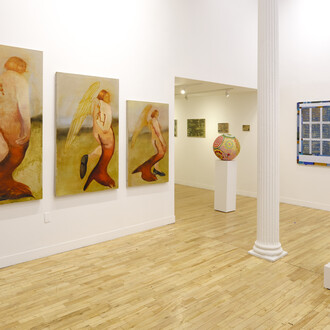Shrine is excited to announce the opening of J.B. Murray: Visions from the Sun, a solo exhibition of drawings and abstract spiritual texts by the self-taught artist, John Bunion Murray.
J. B. Murray (1908-1988) was an African American farmer who lived in rural Glascock County, Georgia. In his later years (at around the age of 70), Murray began experiencing hallucinatory visions and communications from God. During his first visionary trance, he described the sun descending down from the sky and into his yard while he was watering his vegetable garden. "After that," he told the artist, Judith McWillie, "The eagle crossed my eye... a spiritual eagle. You know the eagle can see farther than any other bird in the world, and that's why I can see things some more folks can't."
Following the onset of what he believed to be direct spiritual transmissions from God as well as the spirits of his deceased relatives, J. B. Murray began to create– First, he started obsessively writing in an abstract and completely unintelligible script on a variety of surfaces including rolls of adding machine tape, stationary paper, medical prescription tablets and even on the walls of his home. To translate and decipher his output, Murray would both draw and then read his highly stylized texts and images through a bottle of "holy" water sourced from a well on his property. In a short film by McWillie, he muses, "This water will work as I speak... This water speaks truth." The artist spent time each day staring at the sun through his water bottles to both recharge and give thanks for his special gift.
Murray's work resonates on multiple social and artistic levels. It falls squarely into place within the spectrum of Southern black expression that followed the Civil Rights Movement in the 1950s and 60s. According to scholars such as Bill Arnett of the Souls Grown Deep Foundation, black artists, who had had been creating privately for generations, began to feel emboldened to more publicly display works of art and create large outdoor environments called yard shows following the voices of powerful civil rights activists such as Martin Luther King Jr. Murray's mediumistic writings and drawings meld with this concept and unconsciously explore the language and imagery of black experience of life in America.
His work is also a vivid example, much like the quilts of Gee's Bend from Alabama, of a defined and abstract art-making practice that is deeply aligned within the Modernist art movement despite the maker's lack of knowledge on the subject or intention to create work for reasons other than personal necessity. It's particularly striking that J.B. Murray, who was illiterate, felt compelled to transcribe God's tongue and invent a vocabulary of abstract forms to broadcast to the world around him without the benefit or understanding of the written word.
















